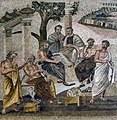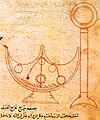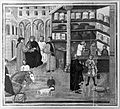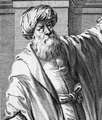Portal:History of science
The History of Science Portal
The history of science covers the development of science from ancient times to the present. It encompasses all three major branches of science: natural, social, and formal. Protoscience, early sciences, and natural philosophies such as alchemy and astrology during the Bronze Age, Iron Age, classical antiquity, and the Middle Ages declined during the early modern period after the establishment of formal disciplines of science in the Age of Enlightenment.
Science's earliest roots can be traced to Ancient Egypt and Mesopotamia around 3000 to 1200 BCE. These civilizations' contributions to mathematics, astronomy, and medicine influenced later Greek natural philosophy of classical antiquity, wherein formal attempts were made to provide explanations of events in the physical world based on natural causes. After the fall of the Western Roman Empire, knowledge of Greek conceptions of the world deteriorated in Latin-speaking Western Europe during the early centuries (400 to 1000 CE) of the Middle Ages, but continued to thrive in the Greek-speaking Byzantine Empire. Aided by translations of Greek texts, the Hellenistic worldview was preserved and absorbed into the Arabic-speaking Muslim world during the Islamic Golden Age. The recovery and assimilation of Greek works and Islamic inquiries into Western Europe from the 10th to 13th century revived the learning of natural philosophy in the West. Traditions of early science were also developed in ancient India and separately in ancient China, the Chinese model having influenced Vietnam, Korea and Japan before Western exploration. Among the Pre-Columbian peoples of Mesoamerica, the Zapotec civilization established their first known traditions of astronomy and mathematics for producing calendars, followed by other civilizations such as the Maya.
Natural philosophy was transformed during the Scientific Revolution in 16th- to 17th-century Europe, as new ideas and discoveries departed from previous Greek conceptions and traditions. The New Science that emerged was more mechanistic in its worldview, more integrated with mathematics, and more reliable and open as its knowledge was based on a newly defined scientific method. More "revolutions" in subsequent centuries soon followed. The chemical revolution of the 18th century, for instance, introduced new quantitative methods and measurements for chemistry. In the 19th century, new perspectives regarding the conservation of energy, age of Earth, and evolution came into focus. And in the 20th century, new discoveries in genetics and physics laid the foundations for new sub disciplines such as molecular biology and particle physics. Moreover, industrial and military concerns as well as the increasing complexity of new research endeavors ushered in the era of "big science," particularly after World War II. (Full article...)
Selected article -
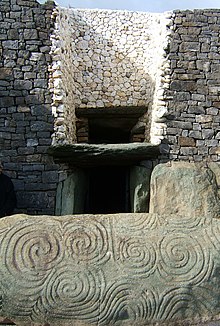
Archaeoastronomy (also spelled archeoastronomy) is the interdisciplinary or multidisciplinary study of how people in the past "have understood the phenomena in the sky, how they used these phenomena and what role the sky played in their cultures". Clive Ruggles argues it is misleading to consider archaeoastronomy to be the study of ancient astronomy, as modern astronomy is a scientific discipline, while archaeoastronomy considers symbolically rich cultural interpretations of phenomena in the sky by other cultures. It is often twinned with ethnoastronomy, the anthropological study of skywatching in contemporary societies. Archaeoastronomy is also closely associated with historical astronomy, the use of historical records of heavenly events to answer astronomical problems and the history of astronomy, which uses written records to evaluate past astronomical practice.
Archaeoastronomy uses a variety of methods to uncover evidence of past practices including archaeology, anthropology, astronomy, statistics and probability, and history. Because these methods are diverse and use data from such different sources, integrating them into a coherent argument has been a long-term difficulty for archaeoastronomers. Archaeoastronomy fills complementary niches in landscape archaeology and cognitive archaeology. Material evidence and its connection to the sky can reveal how a wider landscape can be integrated into beliefs about the cycles of nature, such as Mayan astronomy and its relationship with agriculture. Other examples which have brought together ideas of cognition and landscape include studies of the cosmic order embedded in the roads of settlements. (Full article...)Selected image
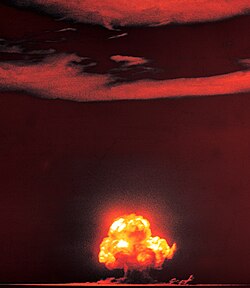
This famous color photograph of the "Trinity" shot, the first nuclear test explosion, was taken by Jack Aeby on July 16, 1945. Aeby was a member of the Special Engineering Detachment at Los Alamos National Laboratory, working under the aegis of the Manhattan Project.
Did you know
... that the Merton Thesis—an argument connecting Protestant pietism with the rise of experimental science—dates back to Robert K. Merton's 1938 doctoral dissertation, which launched the historical sociology of science?
...that a number of scientific disciplines, such as computer science and seismology, emerged because of military funding?
...that the principle of conservation of energy was formulated independently by at least 12 individuals between 1830 and 1850?
Selected Biography -

Srinivasa Ramanujan (22 December 1887 – 26 April 1920) was an Indian mathematician. Though he had almost no formal training in pure mathematics, he made substantial contributions to mathematical analysis, number theory, infinite series, and continued fractions, including solutions to mathematical problems then considered unsolvable.
Ramanujan initially developed his own mathematical research in isolation. According to Hans Eysenck, "he tried to interest the leading professional mathematicians in his work, but failed for the most part. What he had to show them was too novel, too unfamiliar, and additionally presented in unusual ways; they could not be bothered". Seeking mathematicians who could better understand his work, in 1913 he began a mail correspondence with the English mathematician G. H. Hardy at the University of Cambridge, England. Recognising Ramanujan's work as extraordinary, Hardy arranged for him to travel to Cambridge. In his notes, Hardy commented that Ramanujan had produced groundbreaking new theorems, including some that "defeated me completely; I had never seen anything in the least like them before", and some recently proven but highly advanced results. (Full article...)Selected anniversaries
July 1:
- 1646 - Birth of Gottfried Leibniz, German mathematician (d. 1716)
- 1742 - Birth of Georg Christoph Lichtenberg, German physicist (d. 1799)
- 1788 - Birth of Jean-Victor Poncelet, French mathematician (d. 1867)
- 1858 - The joint reading of Charles Darwin and Alfred Russel Wallace's papers on evolution to the Linnean Society
- 1906 - Birth of Jean Dieudonné, French mathematician (d. 1992)
- 1929 - Birth of Gerald Edelman, American biologist, Nobel laureate
- 1941 - Birth of Alfred G. Gilman, American scientist, Nobel laureate
- 1957 - The International Geophysical Year begins (until December 31, 1958)
- 1968 - The Nuclear non-proliferation treaty is signed in Washington, London and Moscow by sixty-two countries
- 1971 - Death of Lawrence Bragg, English physicist, Nobel Prize laureate (b. 1890)
- 2001 - Death of Nikolay Basov, Russian physicist, Nobel Prize laureate (b. 1922)
- 2004 - Saturn orbit insertion of Cassini–Huygens begins at 01:12 UTC and ends at 02:48 UTC
Related portals
Topics
General images
Subcategories
Things you can do
Help out by participating in the History of Science Wikiproject (which also coordinates the histories of medicine, technology and philosophy of science) or join the discussion.
Associated Wikimedia
The following Wikimedia Foundation sister projects provide more on this subject:
-
Commons
Free media repository -
Wikibooks
Free textbooks and manuals -
Wikidata
Free knowledge base -
Wikinews
Free-content news -
Wikiquote
Collection of quotations -
Wikisource
Free-content library -
Wikiversity
Free learning tools -
Wiktionary
Dictionary and thesaurus






